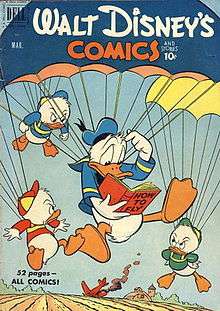A Financial Fable
| "A Financial Fable" | |
|---|---|
 Walt Disney's Comics and Stories #126 (March 1951) | |
| Story code | W WDC 126-02 |
| Story | Carl Barks |
| Ink | Carl Barks |
| Date | September 14, 1950 |
| Hero | Donald Duck |
| Pages | 10 |
| Layout | 4 rows per page |
| Appearances |
Donald Duck Scrooge McDuck Gladstone Gander Huey, Dewey and Louie |
| First publication |
Walt Disney's Comics and Stories #126 March 1951 |
"A Financial Fable" (also known as "The Cyclone Money Crib") is a Donald Duck comic book story written and illustrated by Carl Barks in September 1950. As with many other Barks stories, it was originally untitled. The story deals with what will happen if everyone in a community becomes a millionaire.
Publications
The story first appeared in Walt Disney's Comics and Stories #126 in March 1951. It has later appeared in Walt Disney's Comics and Stories #363 (December 1970) and #489 (August 1981), Uncle Scrooge Adventures #23 (November 1993), Uncle Scrooge #326 (February 2004), and other publications.[1]
Outside of the United States, the story has been published in Australia, Belgium, Brazil, Chile, Denmark, the Faroe Islands, Finland, France, Germany, Greece, Italy, the Netherlands, Norway, Poland, Romania, Spain, Sweden, and probably other countries.[1]
Plot
Scrooge McDuck is running a farm, employing his nephews as farmhands. While Huey, Dewey and Louie enjoy working, Donald Duck is tired of labour and quits the job, joining his lucky cousin Gladstone Gander in searching for luck and money.
Scrooge keeps all his money in a corn crib at the farm. When a cyclone hits the crib, the cash is spread all over the area. Scrooge is not upset, knowing that if he and his young nephews keep working, they will get the money back soon enough.
Meanwhile, Gladstone is demonstrating his unbelievable luck, holding out his hat and asking for some money to land in it. Two million of Scrooge's dollars then fall down from the sky and land in the hat. The two cousins decide to spend the money on traveling, and drive to the local village to buy gas. When they arrive, they learn that money has been raining over the villagers too, and now that everyone is a millionaire, no one is working anymore. Therefore, they cannot buy gas, or take the bus, or even buy good shoes so that they can walk to a town where they can buy something. Donald gives up, and returns to his uncle, where he gets his job back, while Gladstone gives Donald his million and goes fishing. Scrooge informs him that if he wants to eat eggs for breakfast, they cost a million each.
Eventually, all the new millionaires go to Scrooge's farm to buy food and perhaps get a job. With the prices having drastically increased — an egg now costs one million dollars, as does a ham, and a cabbage costs two million — Scrooge soon gets all of his money back, and everything is back to normal.
Analysis
The message of the story has been described as politically right-wing. Ed Natcher of Prism Comics wrote that Barks "wrote from a socio-economic viewpoint that was somewhat to the right of Ayn Rand" and that the story could make "any Bush blush with envy at its conservative credentials".[2] Donaldist Jon Gisle called the story "a classic defence of the capitalistic system".[3]
Gunnar Bårdsen, a Norwegian professor of economics, has pointed out the similarities between the story and Nobel prize-winning economist Milton Friedman's 1969 theories of "helicopter money".[4]
Barks himself called "A Financial Fable" a "story of easy riches" and said that the message of the story surely would get him "in a cell in a Siberian gulag someday."[5]
See also
References
- 1 2 A Financial Fable at the INDUCKS
- ↑ Natcher, Ed (2006). "A Financial Fable". Prism Comics. Retrieved February 13, 2008.
- ↑ Gisle, Jon (2006) [1973]. Donaldismen (in Norwegian). Gyldendal. p. 80.
- ↑ Oksholen, Tore (June 2006). "Nobel Donald". Gemini (in Norwegian): 21–23. Retrieved 2008-02-13.
- ↑ Kylling, Peter (2006-04-28). "The Economist". cbarks.dk. Retrieved February 13, 2008. External link in
|work=(help)
External links
- A Financial Fable at the INDUCKS